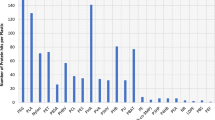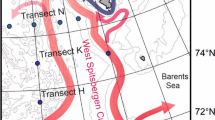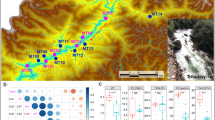Abstract
The present study compared the taxonomic diversity and evaluated the functional attributes of the bacterial species from Mandovi and Zuari mangrove sediments, Goa, using paired-end amplicon sequencing of 16S rDNA and culture-based analyses, respectively. 16S rDNA sequencing revealed Proteobacteria, Firmicutes, and Actinobacteria as the dominant phyla in both the sediments. However, the abundance of these phyla significantly differed between the samples. Bacteroidetes from Mandovi sediment, and Acidobacteria and Gemmatimonadetes from Zuari sediment were the other exclusive major phyla. Chloroflexi, Cyanobacteria, Nitrospirae, Planctomycetes, Verrucomicrobia, and WS3 were the minor phyla observed in both. However, a significant difference in the distribution of minor phyla and lower bacterial taxa under each phylum was noted between the sediments, indicating that the resident microbial flora completely differed between them. This was further validated by high values from distance matrix analyses between the samples. In addition, the pathogenic Vibrio sp. was recorded exclusively in Mandovi sediment, while higher abundance of ecologically important bacterial classes including Gammaproteobacteria, Alphaproteobacteria, Deltaproteobacteria, and Bacilli was observed in Zuari sediment. Taken together, the data indicated that Zuari sediment was taxonomically richer than Mandovi sediment, while a greater incidence of anthropogenic activities occurred in the latter. This observation was further validated by non-parametric richness estimators which were found to be higher for Zuari sediment. The cultured bacterial isolates, all identified as Firmicutes, were tested for activities related to biofertilization and production of enzymes to be used for bioremediation and chemotherapeutic applications. Higher number of bacterial isolates from Mandovi was found to produce indole-acetic-acid, tannase, xylanase, and glutaminase enzymes, and could solubilize phosphate. In contrast, higher proportion of bacterial isolates from Zuari sediment were capable of producing amylase, cellulase, gelatinase, laccase, lipase, protease, and asparaginase enzymes, emphasizing the fact that the Zuari mangrove sediment is a rich reservoir for economically and biotechnologically important bacterial species.



Similar content being viewed by others
References
Aizpuru M, Achard F, Blasco F (2000) Global assessment of cover change of the mangrove forests using satellite imagery at medium to high resolution. In: EEC Research project n 15017-1999-05 FIED. ISP FR–Joint Research Centre, Ispra
Ali B, Sabri AN, Ljung K, Hasnain S (2009) Auxin production by plant associated bacteria: impact on endogenous IAA content and growth of Triticum aestivum L. Lett Appl Microbiol 48(5):542–547. https://doi.org/10.1111/j.1472-765X.2009.02565.x
Alzubaidy H, Essack M, Malas TB, Bokhari A, Motwalli O, Kamanu FK, Jamhor SA, Mokhtar NA, Antunes A, Simões MF, Alam I, Bougouffa S, Lafi FF, Bajic VB, Archer JA (2016) Rhizosphere microbiome metagenomic of gray mangroves (Avicennia marina) in the Red Sea. Gene 576:626–636. https://doi.org/10.1016/j.gene.2015.10.032
Andreote FD, Jiménez DJ, Chaves D (2012) The microbiome of Brazilian mangrove sediments as revealed by metagenomics. PLoS One 7(6):e38600. https://doi.org/10.1371/journal.pone.0038600
Bai S, Li J, He Z, Van Nostrand JD, Tian Y, Lin G, Zhou J, Zheng T (2013) GeoChip-based analysis of the functional gene diversity and metabolic potential of soil microbial communities of mangroves. Appl Microbiol Biotechnol 97(15):7035–7048. https://doi.org/10.1007/s00253-012-4496-z
Balakrishnan S, Indira K, Srinivasan MJ (2015) Mosquitocidal properties of Bacillus species isolated from mangroves of Vellar estuary, Southeast coast of India. Parasit Dis 39(3):385–392. https://doi.org/10.1007/s12639-013-0371-9
Balan SS, Nethaji R, Sankar S, Jayalakshmi S (2012) Production of gelatinase enzyme from Bacillus spp. isolated from the sediment sample of Porto Novo Coastal sites. Asian Pac J Trop Biomed 2:S1811–S1816
Basak P, Majumder NS, Nag S, Bhattacharyya A, Roy D, Chakraborty A, SenGupta S, Roy A, Mukherjee A, Pattanayak R, Ghosh A, Chattopadhyay D, Bhattacharyya M (2015) Spatiotemporal analysis of bacterial diversity in sediments of Sundarbans using parallel 16S rRNA gene tag sequencing. Microb Ecol 69(3):500–511. https://doi.org/10.1007/s00248-014-0498-y. (Epub 2014 Sep 26)
Bhattacharyya P, Chakrabarti K, Tripathy S, Chakraborty A, Kim K, Kim SH (2007) L-asparaginase and L-glutaminase activities in submerged rice soil amended with municipal solid waste compost and decomposed cow manure. J Environ Sci Health B 42(5):593–598. https://doi.org/10.1080/03601230701389462
Bhattacharyya A, Majumder NS, Basak P, Mukherji S, Roy D, Nag S, Haldar A, Chattopadhyay D, Mitra S, Bhattacharyya M, Ghosh A (2015) Diversity and distribution of Archaea in the Mangrove sediment of Sundarbans. Archaea 2015:968582. https://doi.org/10.1155/2015/968582
Bicholker AA, Nazareth SW (2015) A comparative study of metal tolerance and sorption capacities of varied fungal genera frommetal—polluted estuarine environments for potential in metal bioremediation. Kavaka 44:16–29
Brahmbhatt D, Modi HA, Jain NK (2014) Preliminary isolation and screening of tannase producing bacteria and fungi. Int J Curr Microbiol Appl Sci 3(11):193–203
Cabral L, Júnior GV, Pereira de Sousa ST, Dias AC, Lira Cadete L, Andreote FD, Hess M, de Oliveira VM (2016) Anthropogenic impact on mangrove sediments triggers differential responses in the heavy metals and antibiotic resistomes of microbial communities. Environ Pollut 216:460–469. https://doi.org/10.1016/j.envpol.2016.05.078
Caporaso JG, Kuczynski J, Stombaugh J, Bittinger K, Bushman FD, Costello EK, Fierer N, Peña AG, Goodrich JK, Gordon JI, Huttley GA, Kelley ST, Knights D, Koenig JE, Ley RE, Lozupone CA, McDonald D, Muegge BD, Pirrung M, Reeder J, Sevinsky JR, Turnbaugh PJ, Walters WA, Widmann J, Yatsunenko T, Zaneveld J, Knight R (2010) QIIME allows analysis of high-throughput community sequencing data. Nat Methods 7(5):335–336. https://doi.org/10.1038/nmeth.f.303
Castaneda LE, Barbosa O (2017) Metagenomic analysis exploring taxonomic and functional diversity of soil microbial communities in Chilean vineyards and surrounding native forests. Peer J 30(5):e3098. https://doi.org/10.7717/peerj.3098
Chaiharn M, Lumyong S (2011) Screening and optimization of indole-3-acetic acid production and phosphate solubilization from rhizobacteria aimed at improving plant growth. Curr Microbiol 62(1):173–181. https://doi.org/10.1007/s00284-010-9674-6
Dias AC, Andreote FD, Rigonato J, Fiore MF, Melo IS, Araújo WL (2010) Brazilian non-disturbed mangrove sediment. Antonie Van Leeuwenhoek 98(4):541–551. https://doi.org/10.1007/s10482-010-9471-z
Edgar RC (2010) Search and clustering orders of magnitude faster than BLAST. Bioinformatics 26(19):2246–2460. https://doi.org/10.1093/bioinformatics/btq461
Fernandes SO, Kirchman DL, Michotey VD, Bonin PC, LokaBharathi PA (2015) Bacterial diversity in relatively pristine and anthropogenically-influenced mangrove ecosystems (Goa, India). Braz J Microbiol 45(4):1161–1171
Ghosh A, Bhadury P (2018) Investigating monsoon and post-monsoon variabilities of bacterioplankton communities in a mangrove ecosystem. Environ Sci Pollut Res Int 25(6):5722–5739. https://doi.org/10.1007/s11356-017-0852-y
Giri C, Long J, Abbas S, Murali RM, Qamer FM, Pengra B, Thau D (2015) Status and distribution of mangrove forests of the world using earth observation satellite data. Glob Ecol Biogeogr 20(1):154–159. https://doi.org/10.1016/j.jenvman.2014.01.020
Gomes NC, Borges LR, Paranhos R, Pinto FN, Mendonça-Hagler LC, Smalla K (2008) Exploring the diversity of bacterial communities in sediments of urban mangrove forests. FEMS Microbiol Ecol 66(1):96–109. https://doi.org/10.1111/j.1574-6941.2008.00519.x
Gupta S, Sharma P, Dev K, Sourirajan A (2016) Halophilic bacteria of Lunsu produce an array of industrially important enzymes with salt tolerant activity. Biochem Res Int 2016:9237418. https://doi.org/10.1155/2016/9237418
Habtom H, Demanèche S, Dawson L, Azulay C, Matan O, Robe P, Gafny R, Simonet P, Jurkevitch E, Pasternak Z (2017) Soil characterisation by bacterial community analysis for forensic applications: a quantitative comparison of environmental technologies. Forensic Sci Int Genet 26:21–29. https://doi.org/10.1016/j.fsigen.2016.10.005
Haldar S, Sengupta S (2015) Impact of plant development on the rhizobacterial population of Arachis hypogaea: a multifactorial analysis. J Basic Microbiol 55(7):922–928. https://doi.org/10.1002/jobm.201400683
Hong Y, Liao D, Hu A, Wang H, Chen J, Khan S, Su J, Li H (2015) Diversity of endophytic and rhizoplane bacterial communities associated with exotic Spartina alterniflora and native mangrove using Illumina amplicon sequencing. Can J Microbiol 61(10):723–733. https://doi.org/10.1139/cjm-2015-0079
Husain I, Sharma A, Kumar S, Malik F (2016) Purification and characterization of glutaminase free asparaginase from Pseudomonas otitidis: induce apoptosis in human leukemia MOLT-4 cells. Biochimie 121:38–51. https://doi.org/10.1016/j.biochi.2015.11.012
Jiang XT, Peng X, Deng GH, Sheng HF, Wang Y, Zhou HW, Tam NF (2013) Illumina sequencing of 16S rRNA tag revealed spatial variations of bacterial communities in a mangrove wetland. Microb Ecol 66(1):96–104. https://doi.org/10.1007/s00248-013-0238-8
Kasana RC, Salwan R, Dhar H, Dutt S, Gulati A (2008) A rapid and easy method for the detection of microbial cellulases on agar plates using gram’s iodine. Curr Microbiol 57(5):503–507. https://doi.org/10.1007/s00284-008-9276-8
Kharangate-Lad A, Bhosle S (2016) Studies on siderophore and pigment produced by an adhered bacterial strain Halobacillus trueperi MXM-16 from the mangrove ecosystem of Goa, India. Indian J Microbiol 56(4):461–466. https://doi.org/10.1007/s12088-016-0591-7
Kim M, Morrison M, Yu Z (2011) Evaluation of different partial 16S rRNA gene sequence regions for phylogenetic analysis of microbiomes. J Microbiol Methods 84(1):81–87. https://doi.org/10.1016/j.mimet.2010.10.020
Magoc T, Salzberg SL (2011) FLASH: fast length adjustment of short reads to improve genome assemblies. Bioinformatics 27(21):2957–2963. https://doi.org/10.1093/bioinformatics/btr507
Mahajan RV, Saran S, Saxena RK, Srivastava AK (2013) A rapid, efficient and sensitive plate assay for detection and screening of l-asparaginase-producing microorganisms. FEMS Microbiol Lett 341(2):122–126. https://doi.org/10.1111/1574-6968.12100
Mendes LW, Taketani RG, Navarrete AA, Tsai SM (2012) Shifts in phylogenetic diversity of archaeal communities in mangrove sediments at different sites and depths in southeastern Brazil. Res Microbiol 163(5):366–377. https://doi.org/10.1016/j.resmic.2012.05.005
Mishra RR, Swain MR, Dangar TK, Thatoi H (2012) Diversity and seasonal fluctuation of predominant microbial communities in Bhitarkanika, a tropical mangrove ecosystem in India. Rev Biol Trop 60(2):909–924
Mobarak-Qamsari E, Kasra-Kermanshahi R, Moosavi-Nejad Z (2011) Isolation and identification of a novel, lipase-producing bacterium, Pseudomnas aeruginosa KM110. Iran J Microbiol 3(2):92–98
Nagar S, Mittal A, Kumar D, Gupta VK (2012) Production of alkali tolerant cellulase free xylanase in high levels by Bacillus pumilus SV-205. Int J Biol Macromol 50(2):414–420. https://doi.org/10.1016/j.ijbiomac.2011.12.026
Poharkar KV, Kerkar S, D’Costa D, Doijad S, Barbuddhe SB (2016) Mangrove ecosystems: an adopted habitat for pathogenic Salmonella spp. Water Environ Res 88(3):264–271. https://doi.org/10.2175/106143016X14504669767733
Rampadarath S, Bandhoa K, Puchooa D, Jeewon R, Bal S (2018) Metatranscriptomics analysis of mangroves habitats around Mauritius. World J Microbiol Biotechnol 34(4):59. https://doi.org/10.1007/s11274-018-2442-7
Ratnaprabha S, Nayak GN (2011) Mudflats in lowermiddle estuary as a favorable location for concentration of metals, west coast of India. Indian J Geomar Sci 40:372–385
Reda FM (2015) Kinetic properties of Streptomyces canarius l-Glutaminase and its anticancer efficiency. Braz J Microbiol 46(4):957–968. https://doi.org/10.1590/S1517-838246420130847
Saxena A, Upadhyay R, Kango N (2015) Isolation and identification of actinomycetes for production of novel extracellular glutaminase free l-asparaginase. Indian J Exp Biol 53(12):786–793
Sharma A, Lal R (2017) Survey of (Meta)genomic approaches for understanding microbial community dynamics. Indian J Microbiol 57(1):23–38. https://doi.org/10.1007/s12088-016-0629-x
Soares Júnior FL, Dias AC, Fasanella CC, Taketani RG, de Souza Lima AO, Melo IS, Andreote FD (2014) Endo- and exoglucanase activities in bacteria from mangrove sediment. Braz J Microbiol 44(3):969–976
Takahashi S, Tomita J, Nishioka K, Hisada T, Nishijima M (2014) Development of a prokaryotic universal primer for simultaneous analysis of Bacteria and Archaea using next-generation sequencing. PLoS One 9(8):e105592. https://doi.org/10.1371/journal.pone.0105592
Tekere M, Mswaka AY, Zvauya R, Read JS (2001) Growth, dye degradation and ligninolytic activity studies on Zimbabwean white rot fungi. Enzyme Microb Technol 28(4–5):420–426
Acknowledgements
The research work was funded by National Post-Doctoral Fellowship Scheme of Science and Engineering Research Board, Department of Science and Technology, New Delhi. The authors thank Goa University, Goa, for providing the necessary infrastructural support for this research work.
Author information
Authors and Affiliations
Contributions
The sample collection, culture-based isolation, and data analysis for both NGS and Sanger sequencing and preparation of manuscript was done by S. Haldar. S. Nazareth contributed in the correction/editing of the manuscript.
Corresponding author
Ethics declarations
Conflict of interest
On behalf of all the authors, the corresponding author declares that there is no conflict of interest.
Rights and permissions
About this article
Cite this article
Haldar, S., Nazareth, S.W. Taxonomic diversity of bacteria from mangrove sediments of Goa: metagenomic and functional analysis. 3 Biotech 8, 436 (2018). https://doi.org/10.1007/s13205-018-1441-6
Received:
Accepted:
Published:
DOI: https://doi.org/10.1007/s13205-018-1441-6




